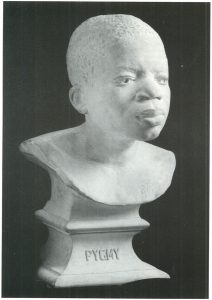Amitava Kumar in Powell’s:
 In the summer of 1904, Ota Benga was bought in the Congo from slave traders for a pound of salt and a bolt of cloth. The man who purchased him was an American entrepreneur and explorer named Samuel Phillips Verner. Verner was under contract to bring pygmies for display at the St. Louis World Fair. Later, Verner was awarded a gold medal for his services to the young discipline of anthropology.
In the summer of 1904, Ota Benga was bought in the Congo from slave traders for a pound of salt and a bolt of cloth. The man who purchased him was an American entrepreneur and explorer named Samuel Phillips Verner. Verner was under contract to bring pygmies for display at the St. Louis World Fair. Later, Verner was awarded a gold medal for his services to the young discipline of anthropology.
In 1906, two years after being exhibited at the World Fair, Ota Benga was brought to the Bronx Zoo and locked in a monkey cage to be displayed under a sign saying “African Pygmy.” His teeth had been filed into sharp points, and this was seen as a sign of cannibalism. Ota Benga was a member of the tribe of Mbuti pygmies; he stood less than five feet tall and weighed only 100 pounds. He spoke no English. He arrived at the Bronx Zoo wearing a white linen suit, in the company of Verner, who was broke. Benga had with him a wooden box, a set of arrows, and his pet chimpanzee. Verner had contacted the zoo’s director in the hopes of securing an apartment for Benga on the zoo’s premises. The director of the Bronx Zoo decided it was better to display Benga in the orangutan’s cage. I read somewhere that bones were scattered about the cage to add a whiff of cannibalism. The zoo attracted as many as 40,000 visitors a day.
More here.
